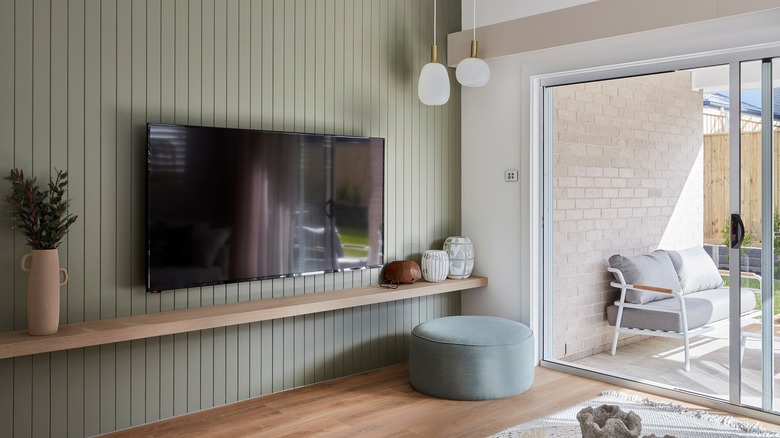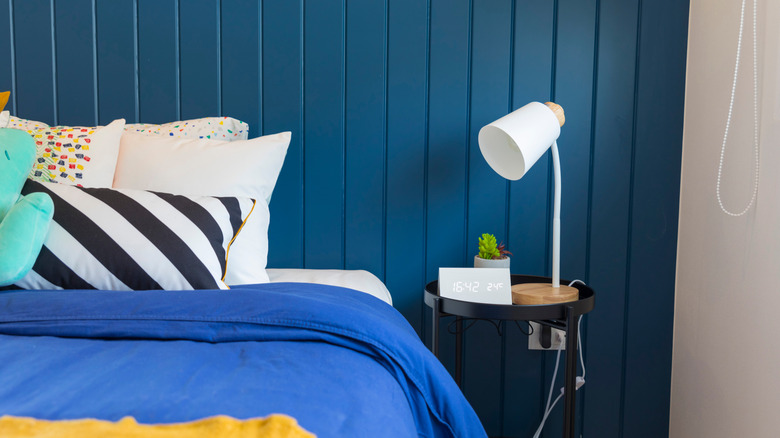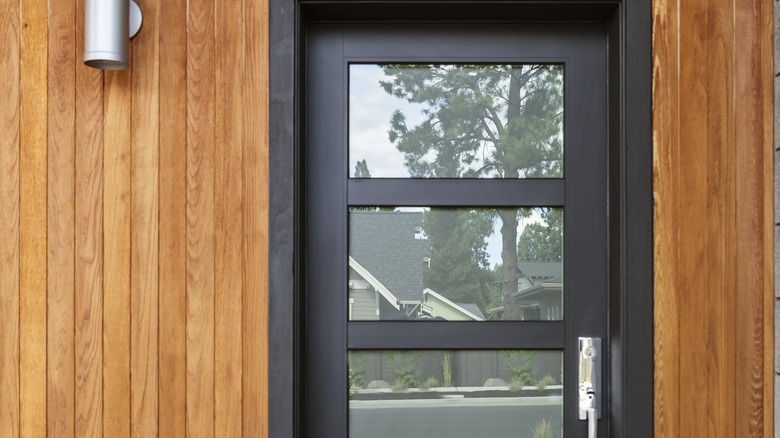Use This Jenny Marrs-Approved Siding To Add Gorgeous Texture To Your Home
The hottest new thing in wall coverings is a wood plank paneling called car siding, thanks to its appearance on "Fixer to Fabulous" and to praise given the material by Jenny and Dave Marrs. Car siding, like tongue-and-groove flooring, typically has a tongue along one edge of each board that interlocks with a groove on the opposite edge of the next board. It usually has a V-shaped decorative groove milled along its length down the center of the reveal. Its name comes from its original use (or the use of something very similar) on train boxcars, and it's sometimes called boxcar siding or a half dozen similar names.
A few things set car siding apart from shiplap, nickel gap, and other plank paneling and siding options. The V-shaped groove down the center of the boards has two implications. First, it makes the boards, when installed, look about half as wide as they actually are. The second is that the bevel of the groove is usually matched in the tongue and groove to keep the two "seams" (one an actual joint, the other a groove that looks like a joint) uniform. Shiplap and other options might or might not have a V-shaped bevel (or another profile), but car siding almost always does. Combined, the bevel and the narrower appearance give car siding a distinctive, rustic feel that is distinct. And in recent years, car siding has usually been installed vertically. All of this works together to make it a unique choice.
The uses and effects of car siding
The rustic effect of car siding has been linked to the cozy country lifestyle evoked by cottagecore style. In her blog, Jenny Marrs describes its use as "a nod to the farmhouse aesthetic that [homeowner] Jodi loves," but it isn't full-on, Joanna Gaines-style modern farmhouse. The apparent narrowness of car siding lends it more of a sense of texture and a slightly less grand, less modern feel. It has a similar effect wherever it's installed. Car siding, like shiplap, can be installed on ceilings and exterior walls as well.
But the biggest factor that makes car siding distinct isn't the material itself but possibly the tendency to install it vertically. Shiplap is typically installed horizontally and usually on interior walls. Car siding can be used horizontally or vertically, and on either interior or exterior walls. While most photos of car siding you'll encounter will be of older horizontal installations, the current trend is a vertical installation with a decidedly less modern look. Vertical car siding might be less evocative of the nautical feeling that horizontal shiplap is often credited with, but with the right décor and accents, you can still create an effective coastal theme in a room with vertical paneling. The retro look of vertical car siding might be most at home in a farmhouse, but very clear boards with a natural finish (and sometimes even painted boards) can even contribute to aesthetics like mid-century modern.
When to choose car siding, inside and out
The "Fixer to Fabulous" living room Jenny Marrs installed car siding in uses the paneling and other rustic elements to ground a very refined look, suggesting age rather than a comparative lack of sophistication. As Dave Marrs puts it in the episode, car siding "looks really historical." It's a good interior option for any room you want to imbue with a sense of cultivated country charm. The exact effect will largely depend on the wall's finish, the room's furnishings, and other cues from your overall aesthetic. Use a vertical orientation to make a small room look either taller or larger overall, especially if you're going for a touch of authenticity grounded in age — but without the coastal overtones.
The use of car siding on exteriors is a whole different matter. Depending, again, on finishes and orientation, the effect can be more retro-modern than country, calling to mind the 1970s (the heyday of wood paneling, after all) more than the 1870s. Car siding can tone down stark modernism or elevate an exterior that seems locked in a historical era. Incidentally, shiplap is actually preferred to car siding for use in wet climes, as it sheds water better than car siding, which will tend to trap it and rot. The use of tongue-and-groove boards for exterior siding might come from the misguided idea that tighter-fitting siding keeps water out of a home's walls.


